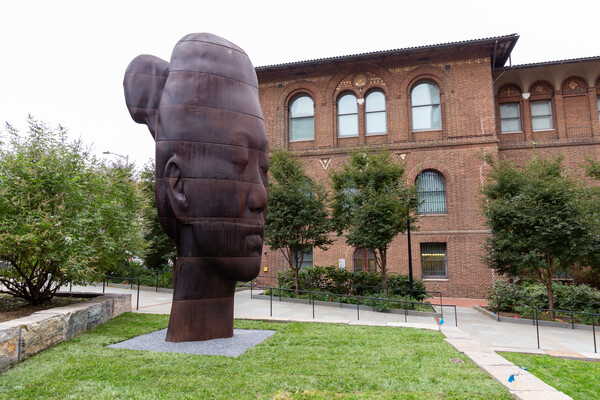
(From left) Doctoral student Hannah Yamagata, research assistant professor Kushol Gupta, and postdoctoral fellow Marshall Padilla holding 3D-printed models of nanoparticles.
(Image: Bella Ciervo)

Winter is the season of white—in snow, in the clouded skies, even in the salt bleaching icy roads. As temperatures ease, the earliest winter blooms are white and yellow, ranging from pale to sun-drenched in color. Wintersweet, witch hazel, winter aconite, snowdrops, hellebores, and forsythia are some of the first blooms to grace bare limbs.
Many of these plants have evolved to fill a precise niche, catering to early pollinators like flies and beetles, says Vince Marrocco, the Gayle E. Maloney Director of Horticulture at the Morris Arboretum & Gardens. Flies lack the full range of color vision and have a preference for long-range stimuli. So, while flies may have difficulty distinguishing a red bloom from surrounding green foliage, white and yellow reflect enough color to stand out.
Wintersweet, or Chimonanthus, is a shrub that can grow more than 20 feet tall, with yellow flowers blossoming anytime from December through March. They also emit a peculiar, almost sickly-sweet scent attractive to beetles in their native habitat, Asia.
Wintersweet is closely related to magnolia, which are early-flowering plants, Marrocco says. They start setting buds in April, grow slow, and after a short dormant period in November or December, start to flower, he says. “It takes a little bit of warmth, then they’ll bloom.”
Wintersweet, like magnolia, evolved during the Jurassic period. “It’s such an early plant that it has developed a mechanism that allows it to bloom with wild temperature swings that take advantage of early pollinators: flies and beetles,” Marrocco says. “That’s why they have really weird fragrances.”
The plant is also unique in its ability to flower during a frost, which usually damages petals. Typically, water expands within the cells of flower petals, causing the cells to expand and the flower to collapse and die. But the petals of wintersweet are waxy, Marrocco says. No water sticks to them. The plant has also developed a mechanism to push the water to the exterior of cell walls, so that the freezing happens between the cells. In warm weather, the flowers expand; in cold, they contract, he says.
Other early bloomers, like witch hazel, will “trial” their blossoms, pushing out a few pioneers with the first flush of warmth to see whether it’s safe, he says. That way, if a couple of blossoms die off, it doesn’t affect the tree’s ability to propagate.
“It’s almost as if they’re trying to hedge their bets,” Marrocco says. “If the temperatures were to swing wildly, only some of the flowers are at risk.”
At Morris, witch hazel generally come to full flower in February, he says. Their blossoms are most commonly vibrant yellow, making an arresting contrast against blue skies, but also range from white to orange and even burgundy. The Morris Arboretum & Gardens recently planted witch hazel in an array of colors with names like “Athena” (a deep red), “Barmstedt Gold” (a deep orange-yellow), and “Candlelight Vigil,” (a bright yellow). The flowers will bloom in an ombré pattern, eventually getting tall enough tie together, creating a tunnel for visitors to traverse.
As the weather warms, winter aconite, hellebores, and snowdrops start to emerge, although some populations of snowdrops bloom in late fall, Marrocco says. Winter aconite and hellebores are both in the buttercup family, he notes. Winter aconite has the closest resemblance to hellebores, with cup-shaped yellow flowers that grow atop lobed foliage in beds or under trees.
Forsythia commonly bloom in March in Pennsylvania, Marrocco says. Unlike wintersweet and witch hazel, forsythia—a vibrant, tangled shrub with bright yellow blooms on bare branches—will not bloom during an isolated warm week. Instead, their blossoms are determined by “growing degree days,” that is, a certain number of hours when the temperatures are warm enough. Forsythia need 400 hours before they bloom, Marrocco says, and are so reliable the Arboretum will base other garden events on forsythia, including mulching and winter pruning.
The garden is a constantly evolving space, Marrocco says. Trees are pruned and maintained. Plants bloom and die and are planted again. It’s all a continual process, a collaboration between plants, human knowledge, and the elements, to create beauty. “Horticulture,” Marrocco says, “is the slowest of the performing arts.”
Kristina Linnea García

(From left) Doctoral student Hannah Yamagata, research assistant professor Kushol Gupta, and postdoctoral fellow Marshall Padilla holding 3D-printed models of nanoparticles.
(Image: Bella Ciervo)

Jin Liu, Penn’s newest economics faculty member, specializes in international trade.
nocred

nocred

nocred